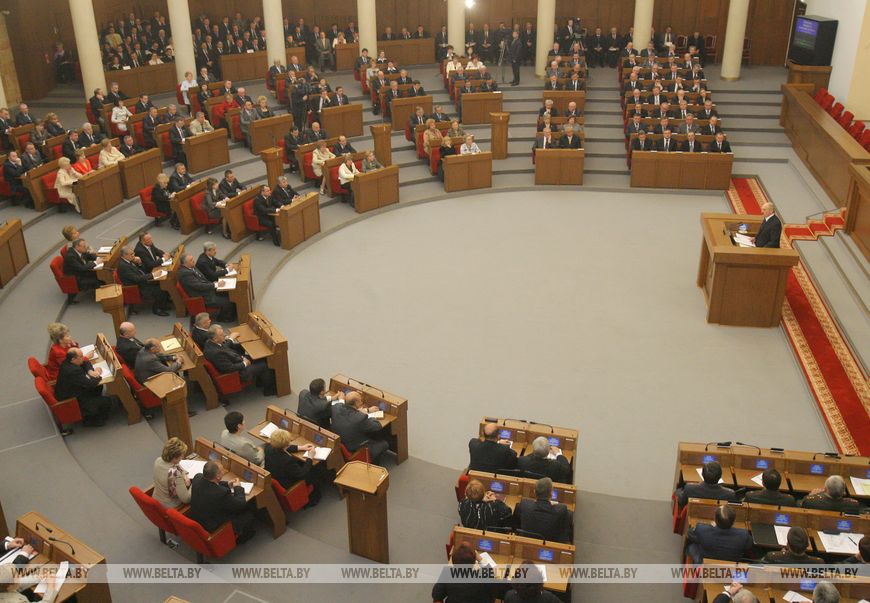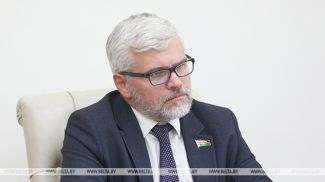
Aleksandr Lukashenko delivers Address to the Belarusian People and the National Assembly, 2009
MINSK, 23 December (BelTA) - What the global financial crisis of 2008-2009 was like and how it affected Belarus was featured in the documentary series Time Chose Us on the Belarus 1 TV channel, BelTA learned. “As usual, Belarus faced the situation not of its making. It was a financial crisis, which was characterized by an imbalance in capital flows and trade. This, accordingly, directly affected Belarus, in terms of exports and availability of capital for the investment cycle. The president's decision was, as always, clear and simple: save enterprises, retain labor teams and restore exports,” said Deputy Head of the Presidential Administration (2009), Economy Minister (2009-2014), First Deputy Prime Minister Nikolai Snopkov.
“As usual, Belarus faced the situation not of its making. It was a financial crisis, which was characterized by an imbalance in capital flows and trade. This, accordingly, directly affected Belarus, in terms of exports and availability of capital for the investment cycle. The president's decision was, as always, clear and simple: save enterprises, retain labor teams and restore exports,” said Deputy Head of the Presidential Administration (2009), Economy Minister (2009-2014), First Deputy Prime Minister Nikolai Snopkov.
In Europe, the crisis was particularly painful. One country after another went bankrupt. It turned out that they were living beyond their means and could not pay off their debts. One example was Iceland, whose economy was touted throughout the 2000s. With Iceland's annual GDP at $13 billion, bank debt totaled $85 billion. The krona depreciated three times in two days. “The crisis would have been much less painful, and maybe not so engrossing, if it were not for the position of the media. But this position was formed by the leaders of the overwhelming majority of states themselves. They promoted and some may even covered up their corrupt practices. The UN already recognized corruption as being at the heart of the current crisis,” Aleksandr Lukashenko said at the time.
“The crisis would have been much less painful, and maybe not so engrossing, if it were not for the position of the media. But this position was formed by the leaders of the overwhelming majority of states themselves. They promoted and some may even covered up their corrupt practices. The UN already recognized corruption as being at the heart of the current crisis,” Aleksandr Lukashenko said at the time.
Another example was Latvia, whose economy was growing at 11% per year before the crisis. But in early 2009, Eurostat recognized that the country had the largest GDP decline in the European Union. In January, the country faced large-scale protests which quickly escalated into clashes with the police.
The crisis also made waves in Belarus. The National Bank monitored the foreign exchange market daily; the employees of the banking sector worked until midnight. In the wake of the currency devaluation at the beginning of the year, Belarusians rushed to the exchange offices and to the stores. People were buying two or three TV sets or refrigerators. The crisis of 2009 led to the decision: to peg the Belarusian ruble exchange rate to a currency basket - of the dollar, euro and the Russian ruble. “In those years, a very strong team of analysts worked in the Economy Ministry. Those were the people who, first of all, understood what should be done, and secondly - loved their country. The question was not what should be done, but how quickly, what tools, what principles to use,” Nikolai Snopkov noted.
The crisis of 2009 led to the decision: to peg the Belarusian ruble exchange rate to a currency basket - of the dollar, euro and the Russian ruble. “In those years, a very strong team of analysts worked in the Economy Ministry. Those were the people who, first of all, understood what should be done, and secondly - loved their country. The question was not what should be done, but how quickly, what tools, what principles to use,” Nikolai Snopkov noted.
The most important thing, he believes, was that decisions were made and implemented quickly: “This is probably why Belarus passed through this period quickly and comfortably.”
MINSK, 23 December (BelTA) - What the global financial crisis of 2008-2009 was like and how it affected Belarus was featured in the documentary series Time Chose Us on the Belarus 1 TV channel, BelTA learned.
 “As usual, Belarus faced the situation not of its making. It was a financial crisis, which was characterized by an imbalance in capital flows and trade. This, accordingly, directly affected Belarus, in terms of exports and availability of capital for the investment cycle. The president's decision was, as always, clear and simple: save enterprises, retain labor teams and restore exports,” said Deputy Head of the Presidential Administration (2009), Economy Minister (2009-2014), First Deputy Prime Minister Nikolai Snopkov.
“As usual, Belarus faced the situation not of its making. It was a financial crisis, which was characterized by an imbalance in capital flows and trade. This, accordingly, directly affected Belarus, in terms of exports and availability of capital for the investment cycle. The president's decision was, as always, clear and simple: save enterprises, retain labor teams and restore exports,” said Deputy Head of the Presidential Administration (2009), Economy Minister (2009-2014), First Deputy Prime Minister Nikolai Snopkov.In Europe, the crisis was particularly painful. One country after another went bankrupt. It turned out that they were living beyond their means and could not pay off their debts. One example was Iceland, whose economy was touted throughout the 2000s. With Iceland's annual GDP at $13 billion, bank debt totaled $85 billion. The krona depreciated three times in two days.
 “The crisis would have been much less painful, and maybe not so engrossing, if it were not for the position of the media. But this position was formed by the leaders of the overwhelming majority of states themselves. They promoted and some may even covered up their corrupt practices. The UN already recognized corruption as being at the heart of the current crisis,” Aleksandr Lukashenko said at the time.
“The crisis would have been much less painful, and maybe not so engrossing, if it were not for the position of the media. But this position was formed by the leaders of the overwhelming majority of states themselves. They promoted and some may even covered up their corrupt practices. The UN already recognized corruption as being at the heart of the current crisis,” Aleksandr Lukashenko said at the time.Another example was Latvia, whose economy was growing at 11% per year before the crisis. But in early 2009, Eurostat recognized that the country had the largest GDP decline in the European Union. In January, the country faced large-scale protests which quickly escalated into clashes with the police.
The crisis also made waves in Belarus. The National Bank monitored the foreign exchange market daily; the employees of the banking sector worked until midnight. In the wake of the currency devaluation at the beginning of the year, Belarusians rushed to the exchange offices and to the stores. People were buying two or three TV sets or refrigerators.
 The crisis of 2009 led to the decision: to peg the Belarusian ruble exchange rate to a currency basket - of the dollar, euro and the Russian ruble. “In those years, a very strong team of analysts worked in the Economy Ministry. Those were the people who, first of all, understood what should be done, and secondly - loved their country. The question was not what should be done, but how quickly, what tools, what principles to use,” Nikolai Snopkov noted.
The crisis of 2009 led to the decision: to peg the Belarusian ruble exchange rate to a currency basket - of the dollar, euro and the Russian ruble. “In those years, a very strong team of analysts worked in the Economy Ministry. Those were the people who, first of all, understood what should be done, and secondly - loved their country. The question was not what should be done, but how quickly, what tools, what principles to use,” Nikolai Snopkov noted.The most important thing, he believes, was that decisions were made and implemented quickly: “This is probably why Belarus passed through this period quickly and comfortably.”
You can learn more about important events in the history of Belarus in BelTA's YouTube project How It Was.













